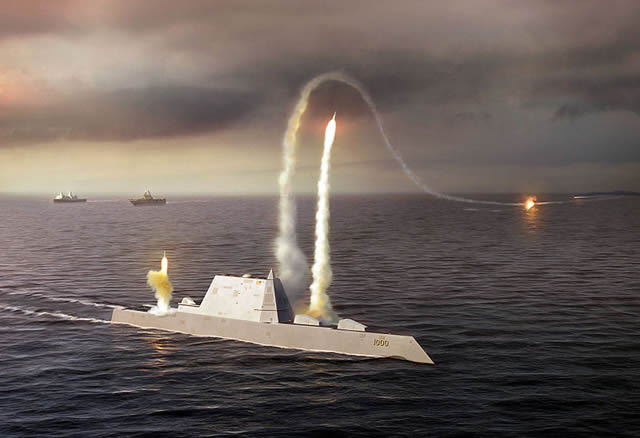The Return of the Zumwalt Guided-Missile Destroyers
Mackenzie Eaglen / Lajos F. Szaszdi /
The U.S. Navy has approved contracts to finish building the hulls of the second and third ships of the Zumwalt class of guided-missile destroyers being constructed at General Dynamics Bath Iron Works in Maine. The $1.8 billion contract will also fund systems integration of the DDG-1001 Michael Monsoor and DDG-1002. The second ship of the class is named after the late Navy SEAL Michael A. Monsoor, who received the Medal of Honor for sacrificing his life for his fellow SEAL team members in Iraq.
Despite the fact that the military is implementing massive budget cuts right now, the Navy’s decision to complete the final two destroyers of the Zumwalt class is sound. As Heritage described at length, Zumwalt destroyers are truly 21st century warships in technological advancements and firepower. Compared to the Arleigh Burke class of guided-missile destroyers, the Zumwalts are the equivalent of the dreadnought battleships at the beginning of the 20th century, with the Arleigh Burkes being comparatively pre-dreadnoughts.
Even though the Navy decided to remove the S-band Volume Search Radar (VSR) from the DDG-1000’s original Dual Band Radar system (due to a Nunn–McCurdy breach), the remaining Raytheon AN/SPY-3 solid state X-band Multifunction Radar is being modified to perform these functions. The antenna of the SPY-3 radar could potentially be built with an antenna aperture with a larger area. The original aperture of the SPY-3 radar is 5.6 square meters compared to the VSR aperture of 16.4 square meters. Raytheon also produces the AN/TPY-2, a solid state X-band multifunction, phased array radar, which is the surveillance and fire-control sensor of the Terminal High-Altitude Air Defense ballistic missile defense system. The antenna aperture of AN/TPY-2 is 9.2 square meters, and SPY-3’s antenna could be enlarged to include more transmit/receive modules, which would allow detection and tracking of more targets. The AN/TPY-2 radar has a detection range of 1,000 km. A modified and enlarged SPY-3 could very well have a ballistic missile defense capability as powerful as the AN/TPY-2. In addition, renowned naval expert Norman Polmar described the SPY-3 radar as capable of directing to target both the Standard SM-2 anti-aircraft and SM-3 missile defense missiles, as well as a new generation of surface-to-air missiles.
As mentioned previously, the Zumwalt class destroyers will have 80 Mk 57 launch cells of the Peripheral Vertical Launch System, with each cell capable of accommodating a quadruple pack with 4 Standard missiles or 4 quad-packs each with 4 Evolved Sea Sparrow Missiles (ESSM), for up to 16 ESSM missiles in a single Mk 57 launch cell. The 28-inch-wide Mk 57 launch system could launch future bigger surface-to-air missiles potentially capable of shooting down Iranian or North Korean ICBMs. Moreover, the DDG-1000 powerful propulsion system can generate 78 megawatts of electricity, which can be used to power a laser weapon capable of intercepting ballistic missiles and even low earth-orbiting satellites, as Raytheon attempted with its laser Sea Lite Beam Director tests. The great electricity generation capacity of the Zumwalts could also power electromagnetic rail guns in the future.
Last but not least, the clean hull and superstructure surfaces of Zumwalt’s stealth design would make it easier to use electronic camouflage, or e-camouflage. As described in our recent blog, micro-cameras covering the surface of the ship would capture real-time images of the vessel’s sea environment. Through advanced computers and the use of metamaterials, the cameras would project those images onto the destroyer’s surfaces above water to make it look like the sky, the sea around it, or a coastline. This could mean visual invisibility for the DDG-1000. This e-camouflage could be in the infrared spectrum, potentially making the surfaces of the ship appear with the cold or warm temperature of the surrounding waters. Zumwalt could also have an active cancellation system to reduce the ship’s radar cross-section by producing an equivalent radar signal out of phase with that of the enemy radar, to cancel it out.
With so few modernization programs being started by the U.S. military these days, the Navy has taken a smart step toward investing in truly leap-ahead technologies and much-needed next-generation shipbuilding advancements that will provide critical applications to other weapons systems and platforms in the future. Once the Navy’s three Zumwalts are sailing the high seas, the nation may just find it needs more of this important capability.

